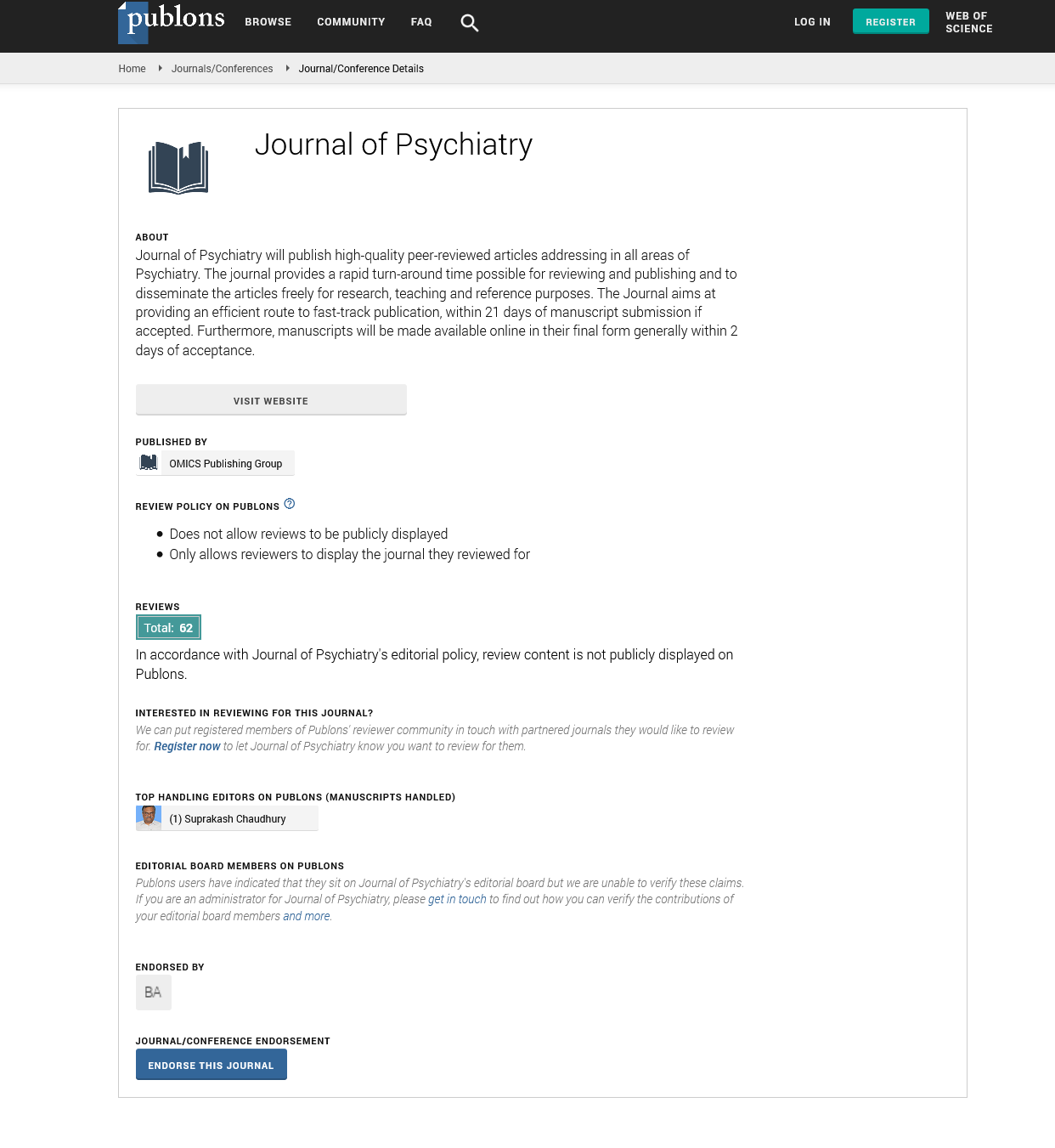Indexed In
- RefSeek
- Hamdard University
- EBSCO A-Z
- OCLC- WorldCat
- SWB online catalog
- Publons
- International committee of medical journals editors (ICMJE)
- Geneva Foundation for Medical Education and Research
Useful Links
Share This Page
Open Access Journals
- Agri and Aquaculture
- Biochemistry
- Bioinformatics & Systems Biology
- Business & Management
- Chemistry
- Clinical Sciences
- Engineering
- Food & Nutrition
- General Science
- Genetics & Molecular Biology
- Immunology & Microbiology
- Medical Sciences
- Neuroscience & Psychology
- Nursing & Health Care
- Pharmaceutical Sciences
Editorial - (2021) Volume 24, Issue 8
Tests Used in Prediction of Depression Risk
Maria Sana*Received: 09-Sep-2021 Published: 30-Sep-2021, DOI: 10.35248/2378-5756.21.24.e002
Editorial Note
According to the World Health Organization, depression is now the leading cause of disability, globally affecting more than 300 million people worldwide. Depression is a condition that outcomes from connections between natural, mental and social variables. In spite of the fact that downturn can become show at whatever stage in life, it regularly first arises during puberty. Distinguishing the danger factors for Depression before clinically jumbling manifestations emerge is vital for focused on and powerful counteraction techniques.
A study which was previously performed by a group from the Max Planck Institute of Psychiatry in Munich, and the Ludwig- Maximilians-Universitaet (LMU) in Munich Medical Center, in a joint effort with specialists at Emory University, (Atlanta, USA), the University of Coimbra (Portugal), and the University of Helsinki (Finland), presents to us a bit nearer to having the option to prevent depression in children and adolescents. The creators have utilized a somewhat new strategy for computing the genetic risk of depression. Traditional genetic studies center around each hereditary contrast in turn and decide its factual relationship with hazard of sickness. In this review, data got from numerous hereditary variations related with depression, which had been recognized in an example of more than 460,000 grown-ups, was utilized to make a score that mirrors the accumulated genetic risk for depression, otherwise called a polygenic danger score. Individually, these variants have little impact on risk, however when taken together they can uncover a generally covered up sickness hazard, consequently giving a much more clear picture. The technique has effectively been used to measure hereditary danger for some normal sicknesses, like heart disease or diabetes.
The score was first calculated from genetic data obtained from a very large number of adults with depression. This parameter was then evaluated in smaller cohorts of children and adolescents to determine whether it could predict depression and symptoms of depression in this age group. Moreover, she examined the effect of an environmental factor childhood abuse which has been found to anticipate depression. We likewise hoped to perceive what a past filled with youth misuse meant for the danger. We tracked down that both the polygenic risk score and exposure to youth misuse were instructive in distinguishing youngsters at risk for depression.
Elisabeth Binder, Director of the Max Planck Institute and Head of the Department in which an exploration was done, sums up the discoveries as follows: This is the primary review to show that the polygenic risk score determined from adults with Depression can be utilized to distinguish youngsters who are in danger of developing depression, before any clinical indications have arisen. Effective psychological and pharmacological interventions for depression are as of now notable. A blend of such interventions has been observed to be best. Lamentably, use of these actions isn't plausible within the circle of general wellbeing, partially because of absence of assets. Gerd Schulte- Körne, Director and Chair of Child and Adolescent Psychiatry, Psychosomatics and Psychotherapy at the LMU Medical Center, and joint head of the review, adds: By applying the discoveries of studies like this one, it ought to be conceivable in future to target youngsters who are at most serious danger for misery, i.e., those with a high polygenic risk score as well as a background marked by childhood abuse, for these compelling interventions.
It concludes there is still a lot of work that needs to be done to perfect the early identification of young people at risk for depression. However, identifying which children are more likely to go on to develop depression would give us the opportunity to implement effective prevention strategies and reduce the huge health burden associated with depression.
Citation: Sana M (2021) Tests Used in Prediction of Depression Risk. J Psychiatry. 24:e002.
Copyright: © 2021 Sana M. This is an open-access article distributed under the terms of the Creative Commons Attribution License, which permits unrestricted use, distribution, and reproduction in any medium, provided the original author and source are credited.

